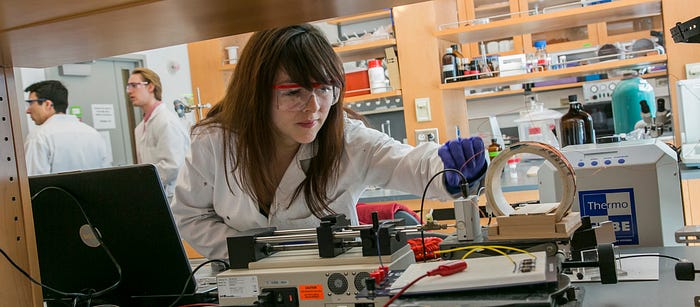Superhero Clothing and Nanotechnology
by Alexandra Chang

When Juan P. Hinestroza, Fiber Science and Apparel Design, Cornell University, traveled to textile dye plants in India and China, he could see what color would be in fashion in New York, Paris, or London by looking at the local river. The experience moved him. “It was very sad, because people drink from and depend on these waters,” says Hinestroza.
Hinestroza’s Textiles Nanotechnology Lab has had a longtime interest in exploring the interface between textiles science and nanoscale science. The group has created and designed such garments as insecticide clothing to fight malaria-infected mosquitos, fabrics that fight germs, and materials that can trap hazardous gases. All of these applications are possible by bringing various types of metal-organic frameworks (MOFs) — nano-crystalline compounds — into everyday textiles such as cotton.
A Dye-less Coloring Process to Benefit the Environment and to Reduce Clothing Waste
One of the lab’s current projects is to make colored fabrics without the use of dyes or pigments. The researchers do this by using MOFs that become excited by UV light and can be made into any color. The lab developed several mechanisms to grow MOFs from cotton, so that they are attached directly into the fiber, not just applied on top.

“The way we construct these MOFs is similar to that of modern construction: we use a foundation by anchoring metals to the cotton and then building the scaffold of the molecule using the anchor as a nucleating node,” says Hinestroza. “They can’t be separated.”
Another apt analogy: think of the MOFs on cotton as pixels on a fabric screen. The researchers create a flexible screen, on which they can make each pixel emit a specific color. So far, the researchers have succeeded in making blues, reds, greens, and combinations thereof.
Not only does this dye-less coloring process benefit the environment, it could reduce clothing waste. “The concept of clothing is mostly based on our perception of color,” says Hinestroza. If you buy a black T-shirt and it gets old, the color often fades to a lighter black, perhaps even gray because of UV-light exposure and washing. “What if the color never looks degraded and looks ‘new’ all the time? That’s possible with this physical color. You’ll always have new clothes.” The ultimate goals are to reduce waste, and on the design side, to create interactive and flexible fabrics that could change color as needed.
Clothing as Batteries
Hinestroza’s lab is also interested in making textile-based batteries — literally clothes that also serve as batteries. The lab uses conjugated copper fibers and micron-sized cavities filled with electrolytes. The fibers are then woven or knitted to create a fabric that is composed of an array of battery cells. For this endeavor, Hinestroza’s group has partnered with a company and a university from Chile, the country with the largest reserves of copper in the world.
Instead of adding bulky batteries onto clothing or adding a wearable, Hinestroza wants to create clothing with functionality without losing the feel of clothing. “Every time you attach something to your body or to your clothing, you become aware of it,” he says. “What we want to do is turn your clothes into an electronic platform. We have already made transistors from cotton; our next step is batteries.”
Though the project is still in an exploratory phase, the goal is to develop one garment that fits all purposes — charging your smartphone, providing live information, shining light when it’s dark, keeping you warm and healthy, and so forth.
The Driving Force of a Multidisciplinary Team of Students
Hinestroza credits his students for driving the research. His lab is multidisciplinary at its core. His students come from across campus and include textiles scientists, apparel designers, chemists, chemical engineers (like himself), business majors, mechanical and biological engineering majors, and even a philosopher.

“They want to explore new fibrous materials from both chemistry and design perspectives,” says Hinestroza. “The most exciting part of my job is when these students come and show me something new and they have this sense of awe. I can tell them, ‘you are the first person in the world that has discovered this,’ and there’s something unique about that. I can witness how the sense of discovery energizes them.”
“We have already made transistors from cotton; our next step is batteries.”
The insecticide garment is a perfect example of the union of disciplines and student-driven research that characterize Hinestroza’s lab. Then-postdoctoral fellow Frederick Ochanda and undergraduate Matilda Ceesay ’13 collaborated to use MOFs to bind mosquito repellent into a bodysuit, hood, and cape outfit. Ochanda was a chemist, originally from Kenya, and Ceesay was a designer, originally from Gambia. Both saw family members suffer from malaria, which remains a leading cause of death in Africa. An insecticide garment could decrease the spread and incidence of malaria.
Hinestroza says that the lab is experimenting with the same materials to kill other types of mosquitoes that are responsible for diseases such as dengue and Chikunguya. They are currently applying for funding to test making the garment on a larger scale.
Inspired by Superhero Costumes
A chemical engineer by training, Hinestroza got into textiles by serendipity, as he puts it. As a graduate student, he chanced upon textiles and thought they could be used as a platform to anchor nanomaterials to large surfaces. “Why don’t we just use the accumulated expertise of centuries of manufacturing textiles and make them better with the ability of controlling materials at the nanoscale?” Hinestroza says he asked at the time.
Inspired by superhero costume designs, Hinestroza persisted in his research until it finally worked. “If a person in the 1940s told a cartoon artist, ‘why are you drawing this superhero with these unique uniforms that do not exist,’ we would never have superheroes, which is sad on its own, but we also would never have these material inventions either,” he says, citing bulletproof, fire-resistant, and low-friction textiles. “I’m a great believer that we can have design-driven science as well as science-driven design.”
To that end, Hinestroza sees his research role as interlocutor of various disciplines coming together in his lab.
“There is equal complexity in designing a molecule as there is to designing a dress, designing legal code, and designing a business strategy,” he explains. “We like to explore how these different ways of thinking can produce outcomes that only one field cannot produce. It’s challenging. Those who actually endure the challenge and are patient with being uncomfortable are the ones that make a difference.”
Some of the Textiles Nanotechnology Lab’s discoveries have already made it to industry. The company iFyber, founded by Cornell alumni in 2008, produces antibacterial wound dressings and diagnostic tools, like one to detect counterfeit garments — both based off of research pioneered in Hinestroza’s lab.
Originally published on the Cornell Research website. All rights are reserved in the images. If you’d like to reproduce the text for noncommercial purposes, please contact us.
